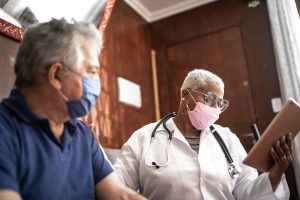Breast Cancer Among Men
Posted on by
Taylor Ellington, MPH
Division of Cancer Prevention and Control
Some may be surprised at the title of this blog: Breast Cancer Among Men. You may be asking yourself, that’s a thing? And the answer is YES! Here are some questions and answers about breast cancer among men and what we learned from some recent research.
How common is breast cancer in men?
Although rare, men can get breast cancer. About 1 out of every 100 breast cancers diagnosed in the United States is found in a man. In 2017, there were about 2,300 new cases of male breast cancer and 500 deaths.
Are there certain types of breast cancers that are more common in men than women?
The most common kinds of breast cancer in men are the same kinds in women—invasive ductal carcinoma, invasive lobular carcinoma, and ductal carcinoma in situ.
What are the risk factors that may increase a man’s chance of getting breast cancer?
Although having risk factors does not mean a man will get breast cancer, there are some things that may increase the risk like genetic mutations, a family history of breast cancer, and certain radiation and hormone therapy treatments. Learn more about these and other risk factors.
CDC recently released an MMWR article on breast cancer survival among males. What are the main findings of this report?
There isn’t a lot of research out there that looks at survival among men with breast cancer, partly because it is rare. We used CDC’s National Program of Cancer Registries data to examine relative survival rates of males diagnosed with breast cancer during 2007–2016. We looked at this by race/ethnicity, age group, diagnosis stage, and US Census region. Among males diagnosed with breast cancer during 2007–2016, 1-year relative survival was 96% and 5-year relative survival was 85%.
What is meant by “relative cancer survival”?
Relative survival looks at the survival rate in a certain group of cancer patients compared with the survival rate in a cancer-free group from the general population.
Were there any major differences in survival rates when looking at race/ethnicity, age group, diagnosis stage, and geographic region?
Yes, non-Hispanic Black males have the lowest 1- and 5-year relative survival rate compared with non-Hispanic Whites and Hispanics. By region, males diagnosed in the West have the highest 1- and 5-year relative survival rate. Males diagnosed at earlier stages (localized and regional) have higher relative survival rates than males diagnosed at distant or unknown stage.
Why are these findings important?
Looking at both 1- and 5-year relative survival rates among males diagnosed with breast cancer may
help guide health care decisions regarding breast cancer testing and treatment among males and help to establish programs to support men at high risk of breast cancer and male breast cancer survivors.
More Information
3 comments on “Breast Cancer Among Men”
Comments listed below are posted by individuals not associated with CDC, unless otherwise stated. These comments do not represent the official views of CDC, and CDC does not guarantee that any information posted by individuals on this site is correct, and disclaims any liability for any loss or damage resulting from reliance on any such information. Read more about our comment policy ».


I have an identical twin brother that had breast cancer in one breast about 6 years ago. When he was diagnosed with breast cancer in his other breast in the fall of 2018 and had a second mastectomy I decided that I should have a more complete exam. I was diagnosed with breast cancer level 1 in both breast and had a double mastectomy. Everything has been fine since these operations with the both of us. The most interesting thing about this case is that we are both BRCA1 and BRCA2 negative. On top of this a complete scan for genes that have shown to show a raise of any cancer was run for my brother and it is ALL negative. The only thing that I can conclude from this is that we still have a lot to learn about gene mutations as indicators for breast cancer.
Earlier it was found that mostly breast cancer are found in womens. but now mens are also suffering from this disease. earlier the death rate also too high. But now, things change with new technology and research. thanks for sharing these informative blog. I really get to knw new things too.
Thank you for sharing this informative blog.